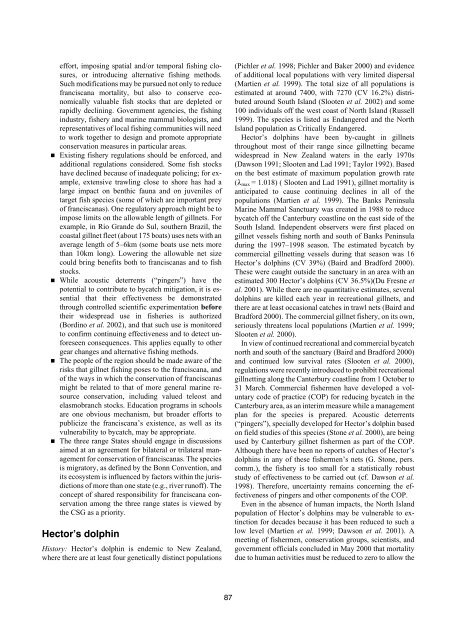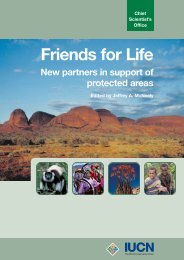Dolphins, Whales and Porpoises: 2002-2010 Conservation - IUCN
Dolphins, Whales and Porpoises: 2002-2010 Conservation - IUCN
Dolphins, Whales and Porpoises: 2002-2010 Conservation - IUCN
Create successful ePaper yourself
Turn your PDF publications into a flip-book with our unique Google optimized e-Paper software.
effort, imposing spatial <strong>and</strong>/or temporal fishing closures,<br />
or introducing alternative fishing methods.<br />
Such modifications may be pursued not only to reduce<br />
franciscana mortality, but also to conserve economically<br />
valuable fish stocks that are depleted or<br />
rapidly declining. Government agencies, the fishing<br />
industry, fishery <strong>and</strong> marine mammal biologists, <strong>and</strong><br />
representatives of local fishing communities will need<br />
to work together to design <strong>and</strong> promote appropriate<br />
conservation measures in particular areas.<br />
� Existing fishery regulations should be enforced, <strong>and</strong><br />
additional regulations considered. Some fish stocks<br />
have declined because of inadequate policing; for example,<br />
extensive trawling close to shore has had a<br />
large impact on benthic fauna <strong>and</strong> on juveniles of<br />
target fish species (some of which are important prey<br />
of franciscanas). One regulatory approach might be to<br />
impose limits on the allowable length of gillnets. For<br />
example, in Rio Gr<strong>and</strong>e do Sul, southern Brazil, the<br />
coastal gillnet fleet (about 175 boats) uses nets with an<br />
average length of 5–6km (some boats use nets more<br />
than 10km long). Lowering the allowable net size<br />
could bring benefits both to franciscanas <strong>and</strong> to fish<br />
stocks.<br />
� While acoustic deterrents (“pingers”) have the<br />
potential to contribute to bycatch mitigation, it is essential<br />
that their effectiveness be demonstrated<br />
through controlled scientific experimentation before<br />
their widespread use in fisheries is authorized<br />
(Bordino et al. <strong>2002</strong>), <strong>and</strong> that such use is monitored<br />
to confirm continuing effectiveness <strong>and</strong> to detect unforeseen<br />
consequences. This applies equally to other<br />
gear changes <strong>and</strong> alternative fishing methods.<br />
� The people of the region should be made aware of the<br />
risks that gillnet fishing poses to the franciscana, <strong>and</strong><br />
of the ways in which the conservation of franciscanas<br />
might be related to that of more general marine resource<br />
conservation, including valued teleost <strong>and</strong><br />
elasmobranch stocks. Education programs in schools<br />
are one obvious mechanism, but broader efforts to<br />
publicize the franciscana’s existence, as well as its<br />
vulnerability to bycatch, may be appropriate.<br />
� The three range States should engage in discussions<br />
aimed at an agreement for bilateral or trilateral management<br />
for conservation of franciscanas. The species<br />
is migratory, as defined by the Bonn Convention, <strong>and</strong><br />
its ecosystem is influenced by factors within the jurisdictions<br />
of more than one state (e.g., river runoff). The<br />
concept of shared responsibility for franciscana conservation<br />
among the three range states is viewed by<br />
the CSG as a priority.<br />
Hector’s dolphin<br />
History: Hector’s dolphin is endemic to New Zeal<strong>and</strong>,<br />
where there are at least four genetically distinct populations<br />
87<br />
(Pichler et al. 1998; Pichler <strong>and</strong> Baker 2000) <strong>and</strong> evidence<br />
of additional local populations with very limited dispersal<br />
(Martien et al. 1999). The total size of all populations is<br />
estimated at around 7400, with 7270 (CV 16.2%) distributed<br />
around South Isl<strong>and</strong> (Slooten et al. <strong>2002</strong>) <strong>and</strong> some<br />
100 individuals off the west coast of North Isl<strong>and</strong> (Russell<br />
1999). The species is listed as Endangered <strong>and</strong> the North<br />
Isl<strong>and</strong> population as Critically Endangered.<br />
Hector’s dolphins have been by-caught in gillnets<br />
throughout most of their range since gillnetting became<br />
widespread in New Zeal<strong>and</strong> waters in the early 1970s<br />
(Dawson 1991; Slooten <strong>and</strong> Lad 1991; Taylor 1992). Based<br />
on the best estimate of maximum population growth rate<br />
(�max = 1.018) ( Slooten <strong>and</strong> Lad 1991), gillnet mortality is<br />
anticipated to cause continuing declines in all of the<br />
populations (Martien et al. 1999). The Banks Peninsula<br />
Marine Mammal Sanctuary was created in 1988 to reduce<br />
bycatch off the Canterbury coastline on the east side of the<br />
South Isl<strong>and</strong>. Independent observers were first placed on<br />
gillnet vessels fishing north <strong>and</strong> south of Banks Peninsula<br />
during the 1997–1998 season. The estimated bycatch by<br />
commercial gillnetting vessels during that season was 16<br />
Hector’s dolphins (CV 39%) (Baird <strong>and</strong> Bradford 2000).<br />
These were caught outside the sanctuary in an area with an<br />
estimated 300 Hector’s dolphins (CV 36.5%)(Du Fresne et<br />
al. 2001). While there are no quantitative estimates, several<br />
dolphins are killed each year in recreational gillnets, <strong>and</strong><br />
there are at least occasional catches in trawl nets (Baird <strong>and</strong><br />
Bradford 2000). The commercial gillnet fishery, on its own,<br />
seriously threatens local populations (Martien et al. 1999;<br />
Slooten et al. 2000).<br />
In view of continued recreational <strong>and</strong> commercial bycatch<br />
north <strong>and</strong> south of the sanctuary (Baird <strong>and</strong> Bradford 2000)<br />
<strong>and</strong> continued low survival rates (Slooten et al. 2000),<br />
regulations were recently introduced to prohibit recreational<br />
gillnetting along the Canterbury coastline from 1 October to<br />
31 March. Commercial fishermen have developed a voluntary<br />
code of practice (COP) for reducing bycatch in the<br />
Canterbury area, as an interim measure while a management<br />
plan for the species is prepared. Acoustic deterrents<br />
(“pingers”), specially developed for Hector’s dolphin based<br />
on field studies of this species (Stone et al. 2000), are being<br />
used by Canterbury gillnet fishermen as part of the COP.<br />
Although there have been no reports of catches of Hector’s<br />
dolphins in any of these fishermen’s nets (G. Stone, pers.<br />
comm.), the fishery is too small for a statistically robust<br />
study of effectiveness to be carried out (cf. Dawson et al.<br />
1998). Therefore, uncertainty remains concerning the effectiveness<br />
of pingers <strong>and</strong> other components of the COP.<br />
Even in the absence of human impacts, the North Isl<strong>and</strong><br />
population of Hector’s dolphins may be vulnerable to extinction<br />
for decades because it has been reduced to such a<br />
low level (Martien et al. 1999; Dawson et al. 2001). A<br />
meeting of fishermen, conservation groups, scientists, <strong>and</strong><br />
government officials concluded in May 2000 that mortality<br />
due to human activities must be reduced to zero to allow the






